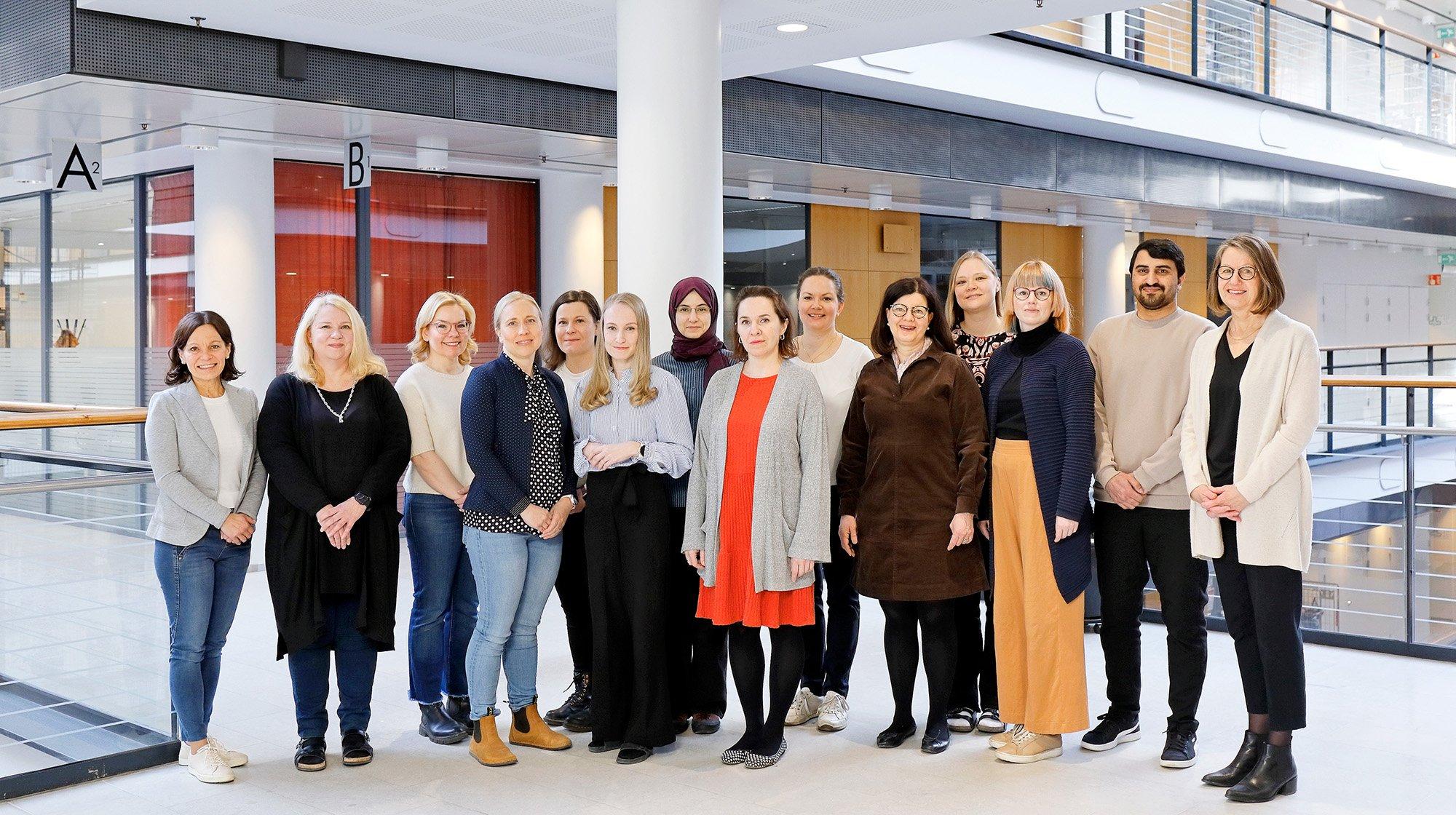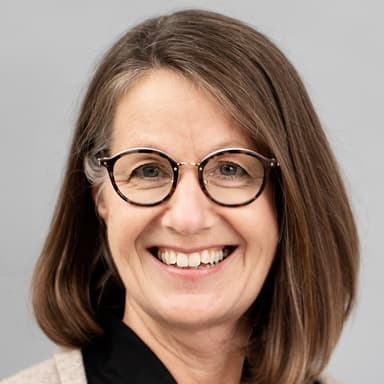
Metabolic Bone Diseases
Our research
By learning more about the genetic causes it is possible to develop new tools for effective screening and early treatment.
We have identified several large families with inherited, childhood-onset osteoporosis, presenting with multiple peripheral and spinal compression fractures by early adulthood.
In many of the families, we have identified the disease-causing gene variant. We have described a heterozygous missense mutation in WNT1 that leads to aberrant WNT signaling and causes an abnormal skeletal phenotype in children and young adults, and several mutations in the X-chromosomal PLS3, causing severe osteoporosis in boys and men. Additionally, we have recently identified heterozygous pathogenic variants in SGMS2 leading to altered sphingolipid metabolism and causing through yet unknown mechanism childhood-onset osteoporosis with or without complex skeletal dysplasia. By exome and whole-genome sequencing studies we have identified several new genes associated with early-onset osteoporosis and studies are ongoing in other families with unidentified genetic causes.

Further studies have revealed altered levels of bone biomarkers FGF23 and DKK1 in WNT1-and PLS3-related osteoporosis, respectively, as well as altered microRNA profiles in these monogenic forms of osteoporosis. These results provide new insights to the mechanisms behind the skeletal pathologies. Currently, we have ongoing in vitro and in vivo studies on WNT1, PLS3, and SGMS2, through national and international collaborations.
We have also studied the role of LRP6, FGF23, WNT16, CRTAP, and several other genes in early-onset osteoporosis and have investigated the effect of genetic variation on bone mineral density and mineral homeostasis in children and adolescents. In addition, we showed that genetic variation in the vitamin D binding protein affects vitamin D status and the response to vitamin D supplementation in infants. Furthermore, we have several other ongoing genetic studies on childhood obesity and bone metabolism, short stature, skeletal dysplasias, and endocrinopathies. For instance, we participated in an American study that identified a new genetic defect that caused growth disorders and a completely new genetic disease. An article published in the journal Science describes the results of the international collaborative study, in which genetic defects in the GNAI2 gene were identified in 20 patients. This study describes a new syndrome belonging to the so-called rasopathies class, which, in addition to growth, involves dysfunction of several organs and systems, notably the immune system.
Read more
Group Leader
Outi Mäkitie
Senior Scientists
Helena Hauta-alus
Saila Laakso
Riikka Mäkitie
Minna Pekkinen, Administrative Group Leader
Svetlana Vakkilainen
Postdoctoral Researchers
Susann Karlberg
Juho Kuula
Petra Loid
Mari Muurinen
Kirsi Määttä
Ahmad Safeer
Doctoral Researchers
Sandra Barck
Laura Koljonen
Zaheer Ahmed
Emilia Träskelä
Staff
Elina Lemola
Mira Ollikainen
Iuliia Savenko
Päivi Turunen
WNT1 Mutations in Early-Onset Osteoporosis and Osteogenesis Imperfecta.
Laine CM, Laine T, Joeng KS, Campeau PM, Kiviranta R, Tarkkonen K, Grover M, Lu JT, Pekkinen M, Wessman M, Heino TJ, Nieminen-Pihala V, Aronen M, Kröger H, Cole WG, Lehesjoki A, Nevarez L, Krakow D, Curry CJR, Cohn DH, Gibbs RA, Lee BH, Mäkitie O. The New England Journal of Medicine. 2013.
Osteoporosis and skeletal dysplasia caused by pathogenic variants in SGMS2.
Pekkinen M, Terhal PA, Botto LD, Henning P, Mäkitie RE, Roschger P, Jain A, Kol M, Kjellberg MA, Paschalis EP, Van Gassen K, Murray M, Bayrak-Toydemir P, Magnusson MK, Jans J, Kausar M, Carey JC, Somerharju P, Lerner UH, Vesa OM, Klaushofer K, Holthuis JC, Mäkitie O. 2019. JCI Insight.
An ARHGAP25 variant links aberrant Rac1 function to early-onset skeletal fragility.
Mäkitie RE, Henning P, Jiu Y, Kämpe A, Kogan K, Costantini A, Välimäki VV, Medina-Gomez C, Pekkinen M, Salusky IB, Schalin-Jäntti C, Haanpää MK, Rivadeneira F, Bassett JHD, Williams GR, Lerner UH, Pereira RC, Lappalainen P, Mäkitie O. JBMR Plus. 2021
Abnormal bone tissue organization and osteocyte lacuno–canalicular network in early-onset osteoporosis due to SGMS2 mutations.
Mäkitie RE, Blouin S, Välimäki VV, Pihlström S, Määttä K, Pekkinen M, Fratzl-Zelman N, Mäkitie O, Hartmann M. JBMR Plus. 2021.
Germline mutations in a G protein identify signaling cross-talk in T cells.
Ham H, Jing H, Lamborn IT, Kober MM, Koval A, Berchiche YA, Anderson DE, Druey KM, Mandl JN, Isidor B, Ferreira CR, Freeman AF, Ganesan S, Karsak M, Mustillo PJ, Teo J, Zolkipli-Cunningham Z, Chatron N, Lecoquierre F, Oler AJ, Schmid JP, Kuhns DB, Xu X, Hauck F, Al-Herz W, Wagner M, Terhal PA, Muurinen M, Barlogis V, Cruz P, Danielson J, Stewart H, Loid P, Rading S, Keren B, Pfundt R, Zarember KA, Vill K, Potocki L, Olivier KN, Lesca G, Faivre L, Wong M, Puel A, Chou J, Tusseau M, Moutsopoulos NM, Matthews HF, Simons C, Taft RJ, Soldatos A, Masle-Farquhar E, Pittaluga S, Brink R, Fink Dl, Kong HH, Kabat J, Kim WS, Bierhals T, Meguro K, Hsu AP, Gu J, Stoddard J, Banos-Pinero B, Slack M, Trivellin G, Mazel B, Soomann M, Li S, Watts VJ, Stratakis CA, Rodriguez-Quevedo MF, Bruel AL, Lipsanen-Nyman M, Saultier P, Jain R, Lehalle D, Torres D, Sullivan KE, Barbarot S, Neu A, Duffourd Y, Similuk M, Mcwalter K, Blanc P, Bézieau S, Jin T, Geha RS, Casanova JL, Makitie OM, Kubisch C, Edery P, Christodoulou J, Germain RN, Goodnow CC, Sakmar TP, Billadeau DD, Küry S, Katanaev VL, Zhang Y, Lenardo MJ, Su HC. Science. 2024.
SGMS2 in primary osteoporosis with facial nerve palsy.
Pihlström S, Richardt S, Määttä K, Pekkinen M, Olkkonen VM, Mäkitie O, Mäkitie RE. Frontiers in endocrinology. 2023.
Variation in the fibroblast growth factor 23 (FGF23) gene associates with serum FGF23 and bone strength in infants.
Enlund-Cerullo M, Holmlund-Suila E, Valkama S, Hauta-Alus H, Rosendahl J, Andersson S, Pekkinen M, Mäkitie O. Frontiers in genetics. 2023.
Biallelic KIF24 Variants Are Responsible for a Spectrum of Skeletal Disorders Ranging From Lethal Skeletal Ciliopathy to Severe Acromesomelic Dysplasia.
Reilly ML, Ain NU, Muurinen M, Tata A, Huber C, Simon M, Ishaq T, Shaw N, Rusanen S, Pekkinen M, Högler W, Knapen MFCM, Van Den Born M, Saunier S, Naz S, Cormier-Daire V, Benmerah A, Mäkitie O. Journal of bone and mineral research: the official journal of the American Society for Bone and Mineral Research. 2022.
Lipocalin-2 is associated with FGF23 in WNT1 and PLS3 osteoporosis.
Loid P, Hauta-Alus H, Mäkitie O, Magnusson P, Mäkitie RE. Frontiers in endocrinology. 2022.
Phosphate Concentrations and Modifying Factors in Healthy Children From 12 to 24 Months of Age.
Koljonen L, Enlund-Cerullo M, Hauta-Alus H, Holmlund-Suila E, Valkama S, Rosendahl J, Andersson S, Pekkinen M, Mäkitie O. The Journal of clinical endocrinology and metabolism. 2021.
Prof. Juha Kere, Prof. Anna-Elina Lehesjoki, Folkhälsan
Doc. Heikki A. Koistinen, Doc. Sanna Toiviainen-Salo, Doc. Helena Valta, Doc. Camilla Schalin-Jäntti, Helsinki University Hospital
Prof. Pertti Panula, Prof. Vesa Olkkonen, University of Helsinki
Dr. Markus Hartmann, Ludwig Boltzmann Institute of Osteology, Vienna, Austria
Prof. Harald Jüppner, Massachusetts General Hospital, Boston, USA
Prof. Fernando Rivadeneira, Erasmus University Rotterdam, The Netherlands
Prof. Olle Kämpe, Karolinska Institutet, Sweden
Prof. Renata Pereira University of California, Los Angeles, USA
Prof. Valérie Cormier-Daire, Université Paris Descartes, Paris, France
Dr. Philippe Campeau, Centre de Recherche, Montréal, Canada
Folkhälsan Research Foundation
Academy of Finland
Novo Nordisk Foundation
Sigrid Jusélius Foundation
Foundation for Pediatric Research
Wilhelm och Else Stockmanns Stiftelse

